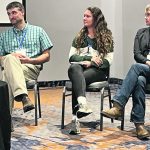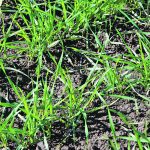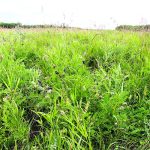Tag Archives forage — page 3

Winter feed supplies a good news story

N.S. farmers face similar challenges to Prairies
Farms may be smaller than those in the West, but they also deal with succession planning, economics and sustainability
HALIFAX — Nova Scotia farms may be small compared to most Prairie operations, but they face similar issues. Farmers on a panel at the Canadian Farm Writers Federation annual conference in early October said succession planning, economics and sustainability are among them. Amber Creamer, policy manager with the provincial agriculture department, said there are 2,050 […] Read more
Anhydrous ammonia boosts forage
If done safely, ammoniated forage can encourage livestock to eat more and result in better nutrition and less spoilage
Glacier FarmMedia – Anhydrous ammonia has long been a critical input for Manitoba’s field crops — now it’s also increasingly finding its way onto livestock operations as a feed enrichment strategy. Molasses has historically been used to enrich lower value forages, but when used safely, farmers are finding anhydrous ammonia can be a better option. […] Read more
Early planted winter cereals bring more and better forage

Forage nurse crops get another look
Study finds establishing a forage stand without a nurse crop could result in stronger growth and increased production
Glacier FarmMedia – A project at the Parkland Crop Diversification Foundation in Roblin, Man., is studying the impact of different phosphorus rates and use of an oat nurse crop in establishing hay crops. The foundation and Ducks Unlimited Canada launched the study in June last year, aiming to identify best management practices for maximizing forage […] Read more
Possibly toxic weed found on Manitoba hay fields

Perennial, annual grazing mixes go head to head
A recent study at the U of S compares production, animal performance and sustainability metrics across grazing mixes
Producers looking to reseed drought-thrashed forage stands might want to check results from a recent University of Saskatchewan study that compared the performance of forage and annual blends under a planned grazing system. Study co-author Jourdyn Sammons presented results during an Ag in Motion rotational grazing lunch and learn July 17, hosted by the Canadian […] Read more
From AIM: Perennial and annual grazing mixes go head-to-head

Quality, weed-free fields key to steady forage business
With nearly 40 years producing forage seed, the Siklenka family has seen some varieties fall in and out of favour
Glacier FarmMedia – Forage seed production may not receive the attention of many other parts of the beef industry, but it plays a crucial role. Nathan Siklenka and his father, Darrel Siklenka, own and operate Siklenka Seed Farm together near Glaslyn, Sask. The farm has been in operation since 1985. The business is well known […] Read more
Producer sets out to counter livestock myths
Survey will gather data from 1991-94 and 2016-19 about all aspects of forage production from seeding to the final crop
CALGARY — A researcher is offering $200 to each Saskatchewan cattle forage producer who completes an online survey he expects will help counter what he called false greenhouse gas narratives targeting the beef industry. Judson Christopherson says he hopes to determine if the amount of carbon that’s being sequestered in soil by forage crops in […] Read more


